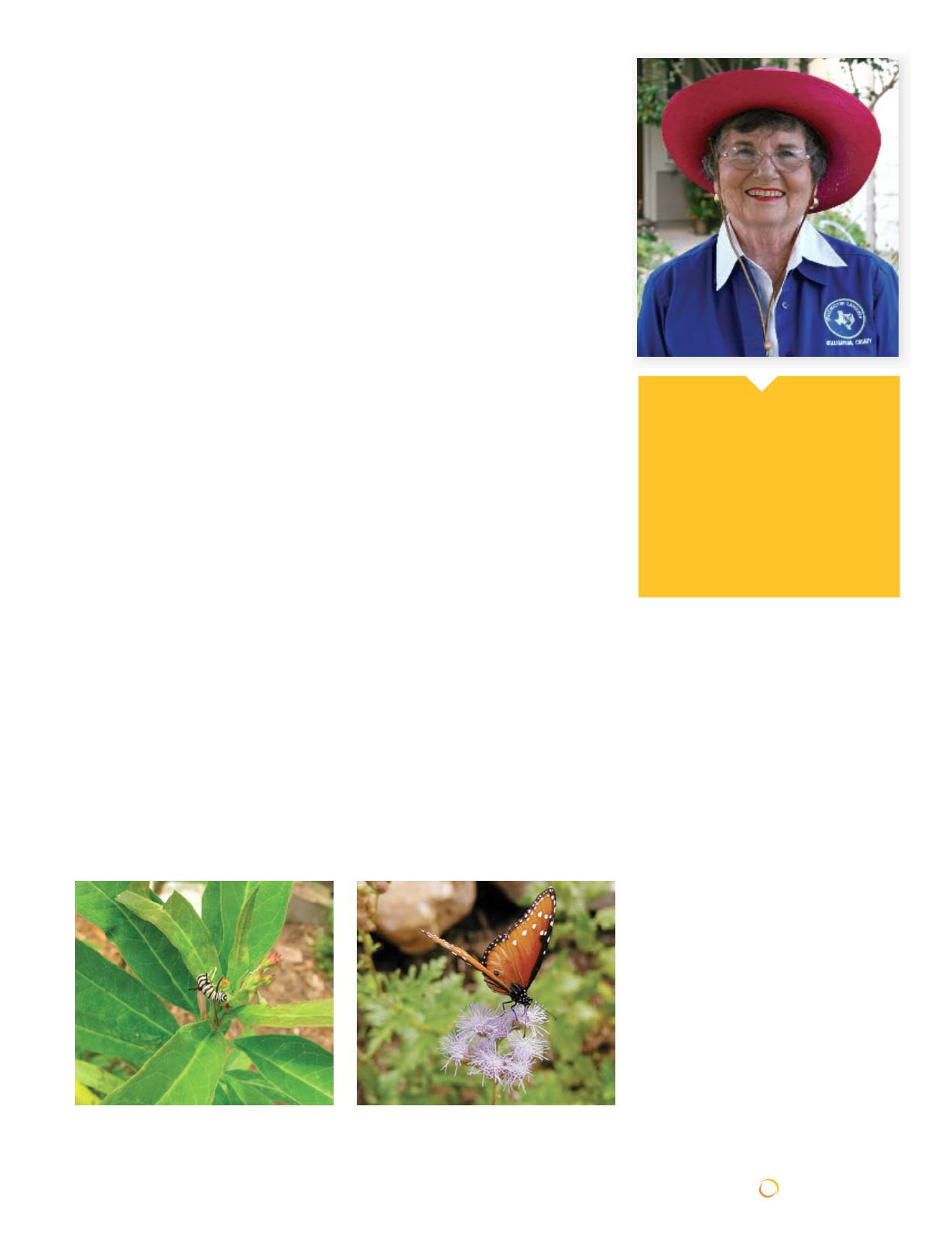
MAY 2014 SUNRAYS | 61
ONLINE:
SCTXCA.ORG
May is a beautiful time of year in central
Texas and one of the joys is preparing
habitat for our abundant wildlife. Why
discuss butterflies when our purpose
is to save water? The more you study
ecology, the more you learn that soil,
plants and wildlife are all part of one
related system—helping one improves
the well-being of all others, including
ourselves. When we build soil to hold
moisture, the result is healthier plants.
When we provide for wildlife by limiting
chemicals and choosing native plants,
the result is a healthier ecosystem for
all to enjoy.
For butterflies, you need both food plants
for caterpillars and plants with nectar
for the adult butterflies. Last summer
I had a fennel plant eaten back almost
to nothing most of the summer. When
anyone commented about it, I would
point to the butterflies on my Gregg’s
mistflower and respond, “That’s why!”
Do not worry if you see caterpillars eat-
ing foliage from plants, as the foliage will
grow back. Swarms of butterflies visited
my Gregg’s mistflower. In doing so, they
pollinated my mistflower while harvest-
ing nectar, which will provide me with
more beautiful flowers this year. Nature
has a way of paying its debts!
It is important to provide food source for
May Tips for a Beautiful
Water Wise Landscape
Next month
:
Next month, join
me for more water wise sugges-
tions for your landscape.
Winola is a Williamson County
Master Gardener, a member of
the Sun City Garden Club and a
member of the Sun City Water Wise
Task Force.
By Winola VanArtsdalen
all our wildlife, especially for the mon-
archs, which are seriously threatened
due to loss of habitat. The butterflies we
see on Gregg’s mistflowers are queens,
as explained to me by fellowMaster Gar-
dener and local butterfly expert, Wayne
Rhoden. Monarchs were rarely seen last
year, but we have many queens who love
the Gregg’s mistflower.
Countless favorite flowers bring but-
terflies to your yard, including: fennel,
parsley, and antelopehorn milkweed
for larval food; and purple coneflower,
phlox, black-eyed Susan, and Gregg’s
mistflower for adult nectar. In the binder
titled
What Grows Here
, prepared by our
Sun City Garden Club (available at both
Monitor Stations), there is a line for each
plant labeled “Attracts” where it is listed
if the plant attracts birds, butterflies,
bees, etc. There is also a reference on the
Garden Club website for a recommended
book on butterflies.
It is late to be planting flowers now, so do
keep new plants close to the house and/
or a water supply to hand water. If you
have a rain barrel, that’s the ideal spot!
MAY gardening tips:
• The best prescription for health in
your landscape is a soil test with the
necessary amendments added, plant-
ing the right plant in the right place,
and avoiding overwatering. Diverse,
abundant native habitat will bring
more beneficial insects and fewer pest
insects.
• Check your irrigation systemmonthly, es-
pecially nowwith summer approaching,
to be sure everything is working properly.
Look to see if there are places you could
change to drip irrigation for the health
of your plants and saving water.
• For healthy turf, keep mower blades
sharp, never mow more than 1/3 the
height of the grass, and minimize fer-
tilizer.
• Bermuda was fertilized earlier. Buffalo
and zoysia can be fertilized late April
to early May. If you spread top dress-
ing, skip this fertilization, or it will be
too much nitrogen.
Source: Texas A&M Agrilife Extension
Service
Horticulture Questions:
Contact Williamson County
AgriLIFE Extension Office at
512-943-3300.
At left, a larva for a queen butterfly on a Mexican butterfly weed, which is the
host plant for the queen. At right is a queen butterfly on a Gregg’s mistflower.
Photos by wayne rhoden


